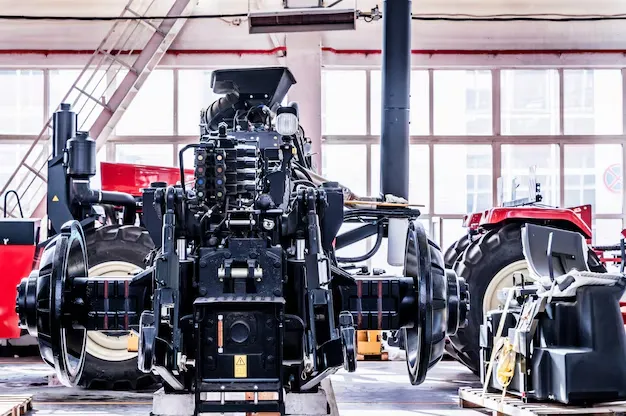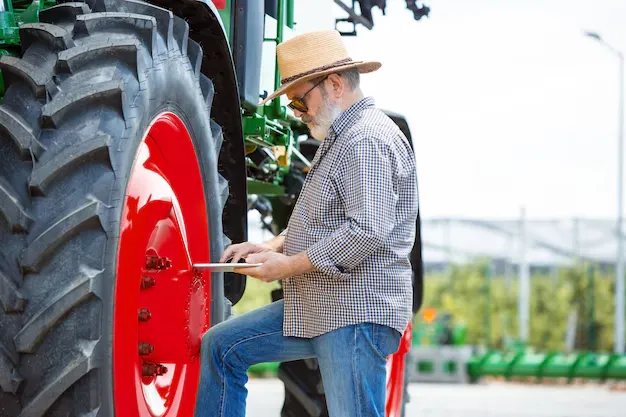Complete Tractor Axle Components Manual

Introduction: Understanding Tractor Axle Parts and Their Importance
Tractor axle parts are critical components that support the vehicle’s weight, transfer power to the wheels, and maintain stability during operation. Axles are essential for ensuring traction, maneuverability, and safety in agricultural machinery. They are designed to withstand heavy loads, rough terrains, and harsh environmental conditions, making them indispensable for efficient farming operations. This comprehensive manual provides detailed information about the various types of tractor axle parts, their functions, and maintenance practices. Whether you’re a farmer, mechanic, or equipment operator, understanding axle systems and components is crucial for optimizing performance, reducing downtime, and extending the lifespan of your tractor.
What Are Tractor Axle Parts?
Tractor axle parts consist of a complex system of components that support the weight of the tractor, transmit power from the engine to the wheels, and maintain stability. These parts include the axle shafts, differential, bearings, seals, housings, and gears. They work together to provide traction, steering, and load-bearing capacity, ensuring reliable performance in challenging agricultural environments.
Why Are Axle Components Crucial for Tractor Performance?
Axle components are essential for maintaining the stability, safety, and maneuverability of tractors. They ensure even weight distribution, optimize power transfer, and provide traction on various terrains. Proper maintenance of axle parts prevents mechanical failures, reduces wear and tear, and extends the life of the tractor. Understanding the importance of axle systems enhances operational efficiency and safety.
Types of Tractor Axles and Their Applications
There are several types of tractor axles, each designed to suit specific agricultural tasks and terrains. The most common types include Front Axles, Rear Axles, and Steering Axles. Additionally, specialized axles such as Live Axles, Dead Axles, and Tandem Axles are used in heavy-duty tractors and implements. Each type of axle provides unique functionality and performance, depending on the tractor’s design, power requirements, and application. Understanding the types and applications of tractor axles helps in selecting the right components for optimal performance and safety.
What Are Tractor Axle Parts?
Tractor axle parts consist of a complex system of components that support the weight of the tractor, transmit power from the engine to the wheels, and maintain stability. These parts include the axle shafts, differential, bearings, seals, housings, and gears. They work together to provide traction, steering, and load-bearing capacity, ensuring reliable performance in challenging agricultural environments.
Rear Axles and Drive Axles: Powering Traction and Stability
Axle components are essential for maintaining the stability, safety, and maneuverability of tractors. They ensure even weight distribution, optimize power transfer, and provide traction on various terrains. Proper maintenance of axle parts prevents mechanical failures, reduces wear and tear, and extends the life of the tractor. Understanding the importance of axle systems enhances operational efficiency and safety.Tractor axle parts consist of a complex system of components that support the weight of the tractor, transmit power from the engine to the wheels, and maintain stability. These parts include the axle shafts, differential, bearings, seals, housings, and gears. They work together to provide traction, steering, and load-bearing capacity, ensuring reliable performance in challenging agricultural environments.Tractor axle parts consist of a complex system of components that support the weight of the tractor, transmit power from the engine to the wheels, and maintain stability. These parts include the axle shafts, differential, bearings, seals, housings, and gears. They work together to provide traction, steering, and load-bearing capacity, ensuring reliable performance in challenging agricultural environments.
Key Components of Tractor Axle Systems

Axle Shafts: Transmitting Power to the Wheels
Axle shafts are solid rods or tubes that transmit power from the differential to the wheels. They are designed to withstand high torque and rotational forces, ensuring reliable power transfer and traction. There are two main types of axle shafts: Semi-Floating Axles and Full-Floating Axles. Semi-floating axles support the weight of the vehicle and transmit torque, while full-floating axles bear only the torque, ensuring better load-bearing capacity and stability.
Differentials: Balancing Wheel Speed and Torque
Differentials are essential components that balance wheel speed and torque during turns. They allow the outer wheel to rotate faster than the inner wheel, ensuring smooth and safe cornering. There are several types of differentials used in tractors, including Open Differentials, Limited-Slip Differentials, and Locking Differentials. Each type provides specific traction and stability benefits, depending on the terrain and application.
Differentials: Balancing Wheel Speed and Torque
Open Differentials: Smooth Cornering and Maneuverability
Open differentials are the most common type used in standard tractors. They allow the outer wheel to rotate faster than the inner wheel during turns, ensuring smooth cornering and maneuverability. However, they provide limited traction on slippery terrains, as power is distributed to the wheel with the least resistance.
Limited-Slip and Locking Differentials: Enhanced Traction
Limited-slip differentials provide better traction by distributing power to both wheels, preventing wheel slippage on uneven terrains. Locking differentials, on the other hand, lock both wheels together, ensuring equal torque distribution and enhanced traction. These differentials are ideal for off-road applications, heavy loads, and challenging agricultural terrains.
Common Issues and Troubleshooting for Tractor Axle Parts
Tractor axle parts are exposed to heavy loads, rough terrains, and environmental stress, making them susceptible to wear and damage. Common issues include Noise and Vibration, Leaking Seals, Differential Failures, and Bearing Wear. Identifying and troubleshooting these issues promptly prevents mechanical failures, reduces downtime, and extends the lifespan of the axle system. Regular inspection, maintenance, and timely replacement of worn-out components are essential for ensuring safe and reliable tractor operations.
Diagnosing Noise and Vibration in Axle Systems
Unusual noise and vibration in axle systems are often caused by worn-out bearings, damaged gears, or misaligned shafts. These issues can lead to mechanical failures and safety risks. Diagnosing noise and vibration requires inspecting bearings, gears, and mounting points for wear, misalignment, or damage. Proper lubrication and timely replacement of worn-out parts prevent further damage and ensure smooth operation.
Identifying and Fixing Leaking Seals
Leaking seals are a common issue in axle systems, leading to fluid loss, contamination, and reduced lubrication. This can result in overheating, increased friction, and component wear. Identifying and fixing leaking seals involve inspecting the axle housing, differential, and wheel hubs for cracks, damage, or worn-out seals. Replacing faulty seals and maintaining proper fluid levels prevent leaks and ensure reliable performance.
Conclusion
Tractor axle parts play a vital role in ensuring stability, traction, power transfer, and overall performance of agricultural machinery. As the backbone of the vehicle’s drivetrain, axles support the weight of the tractor, distribute power to the wheels, and maintain control and maneuverability on challenging terrains. From front steering axles to rear drive axles and differentials, each component is engineered to withstand heavy loads, extreme conditions, and continuous operation. Understanding the functions, types, and maintenance requirements of axle systems is essential for optimizing efficiency, reducing downtime, and extending the lifespan of your tractor.
Proper maintenance of tractor axle parts is crucial for preventing mechanical failures, enhancing safety, and minimizing operational costs. Regular inspection, cleaning, lubrication, and timely replacement of worn-out components prevent premature wear, corrosion, and misalignment. Maintaining correct fluid levels and using high-quality lubricants reduce friction, overheating, and component wear, ensuring smooth and reliable operation. Additionally, understanding the compatibility and specifications of axle parts helps in choosing the right replacements and upgrades, optimizing performance and durability.
Choosing high-quality and compatible axle parts is equally important for maintaining the structural integrity and safety of the tractor. Genuine OEM parts provide precise fitment, consistent performance, and long-term reliability, preserving the original design and functionality of the tractor. On the other hand, reputable aftermarket parts offer cost-effective alternatives without compromising quality. By sourcing axle components from trusted suppliers, farmers and equipment operators can ensure safety, compatibility, and durability, reducing the risk of mechanical failures and costly repairs.
The future of tractor axle systems is driven by technological advancements, including smart axles with IoT-enabled sensors for real-time monitoring, predictive maintenance, and remote diagnostics. These innovations enhance operational efficiency, safety, and decision-making by providing accurate data on axle health, fluid levels, temperature, and wear patterns. Additionally, lightweight and high-strength materials, such as advanced composites and alloys, are being used to improve durability, reduce weight, and optimize fuel efficiency. By embracing these innovations, agricultural professionals can enhance productivity, safety, and profitability.
In conclusion, maintaining and optimizing tractor axle parts is critical for achieving high performance, safety, and operational efficiency. By understanding the functions, types, and maintenance practices of axle systems, farmers and equipment operators can maximize productivity and minimize downtime. Choosing high-quality, compatible, and reliable axle components ensures durability, safety, and long-term cost savings. As agricultural machinery continues to evolve with smart technologies and advanced materials, investing in modern and well-maintained axle systems is essential for staying competitive and achieving sustainable farming success. By prioritizing axle maintenance and embracing innovative solutions, you can enhance the performance, safety, and longevity of your tractor, driving agricultural productivity to new heights
